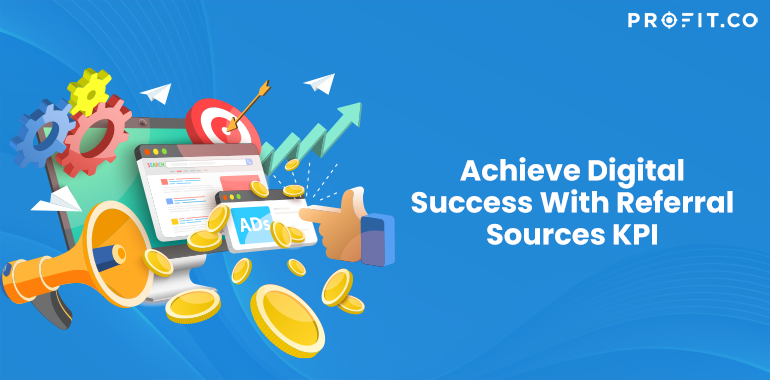Hello, Progressive Marketer! This blog is precisely the one you need to read. Whether you’re trying to make sense of the maze of website traffic or aiming to optimize your digital channels, understanding the “Referral Sources” KPI is critical. Let’s unpack this metric and discover how it can be a game-changer for your strategies.
What is meant by Referral Sources?
Imagine being at a bustling party. People are coming in from the front door, the back door, and perhaps even a sneaky window or two. In the digital world, your website is that party, and referral sources tell you exactly which doors (or windows) your guests (read: visitors) are using to crash your awesome party.
Simply put, referral sources pinpoint where your traffic originates. This insight helps you understand which channels are introducing visitors to your brand.
The Internet is becoming the time square for the global village of tomorrow.
Types of Referral Sources
There’s more than one way to stumble upon a great website. Let’s look at some common referral types:
- Direct: The loyal folks who type in your URL or click on a bookmark. Think of them as your BFFs with a standing invite to your parties.
- Organic Search: These visitors found you through a search engine query. So, if Jane types “awesome digital marketing blogs” and lands on your site, that’s organic for you.
- Paid Search: Jane again, but this time, she clicked on your ad from her search results.
- Social: Traffic pouring in from social platforms. If Tom clicks on your post from Twitter, then Twitter is your referral source.
- Email: Traffic from your newsletter or marketing campaigns. Remember that newsletter you sent last week with that irresistible subject line? Yes, that one.
stay ahead of the curve by mastering your referral source
Who is it Useful for?
Everyone in the digital world! But let me list the most significant ones:
- Digital Marketing Managers: To understand campaign effectiveness.
- Content Creators: To gauge which content pieces are gaining traction.
- SEO Specialists: To determine if their efforts are bearing fruit.
- Business Owners: For a macro view of where web traffic originates.
How is it Calculated?
Analytics platforms, like Google Analytics, perform the math magic for you. They track users as they navigate to your site and categorize their sources. The analytics dashboard can provide the percentage or the exact number of users from each referral source.
How can OKRs be Used to Track this KPI?
Objective and Key Results (OKRs) are a fantastic way to monitor progress toward a goal. If increasing traffic from a specific referral source is your goal, OKRs can help.
Objective: Boost organic search traffic by 20% in Q2.
KR1: Increase keyword rankings for our top 50 keywords from an average position of 30 to an average position of 27 (a 10% increase).
Initiative: Conduct a comprehensive keyword audit and optimization.
KR2: Decrease website bounce rate from 60% to 55% from organic search.
Initiative: Optimize landing pages for better user experience.
KR3: Increase backlinks from a current count of 100 to 120 from high-authority domains.
Initiative: Launch a guest blogging campaign.
Analyzing Referral Sources
Understanding where your traffic originates spotlights successful channels and exposes potential weak spots. It helps you answer crucial questions. Are your paid campaigns worth the investment? Is your content being shared organically as you intended? Which collaborations or partnerships are working in your favor?
Understanding referral sources offers you an eagle-eye view of your marketing efforts. This perspective is essential for fine-tuning your strategies. For example, if you notice an unexpected surge in traffic from a particular blog or influencer, this could be an excellent opportunity to foster that relationship further, considering collaboration or sponsorship.
Furthermore, consistently tracking and analyzing referral data can help you detect seasonal trends or shifts in user behavior. Such patterns might be invaluable for future campaign planning. For instance, if every time you host a webinar or participate in an industry event, there’s a spike in your website visits, this might indicate such engagements resonate with your audience, prompting further investment.
Referral Data and Competitive Edge
Staying a step ahead of competitors is pivotal. With a keen understanding of your referral sources, you can spot emerging platforms or trends before they become mainstream. A new social media platform where users discuss your brand or a forum or community might have taken an interest in your offerings. Being the early bird in such scenarios allows you to capture audiences before competitors even realize there’s a new playing field.
Making the Most of Referral Insights
Harnessing the potential of referral data extends beyond merely examining numbers. It’s about adapting, learning, and evolving. As digital platforms evolve, keeping a pulse on your referral sources ensures your brand remains relevant, engaged, and top-of-mind for potential customers.
Want a deeper understanding of your audience?
Related Articles
-
Understanding Planned Value and Its Importance in Project Management
In project management, monitoring and measuring progress are essential to ensuring that projects stay on track and deliver expected results.... Read more
-
How to Calculate Billable Utilization and Why It Matters for Your Business
Introduction In the professional services world, tracking how much time your employees spend on billable projects is crucial. Billable utilization... Read more
-
What Is Budget Variance? A Simple Guide to Understanding and Managing It
Introduction Have you ever set a budget for something, only to find out later that you spent way more or... Read more
-
Maximize Project Success with a High Project Completion Rate (PCR)
Keeping track of progress and success is essential for any project. Projects need to be completed on time and within... Read more

